Fuji Sakura 50 Sen Note from 1938
Hello Silver & Gold stackers! Another week and another one of the banknotes I picked up a few weeks ago. Er, notes. This one can't really use that word "banknote". But we'll get that that. I'm talking about this guy:
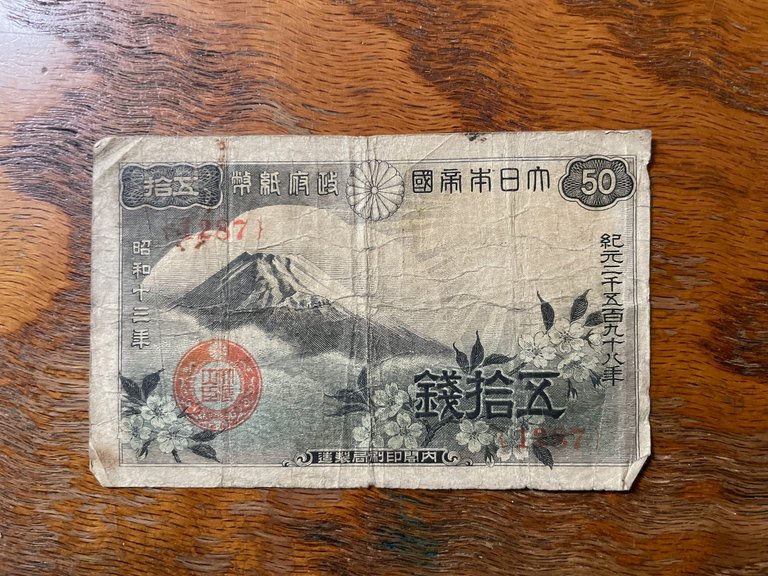
This is for 50 sen. The sen was an old currency denomination equal to 1/100. At one time it was equal to the US penny. By 1938, however, the official exchange rate had fallen to ¥3.6:$1, making this 50 sen note equal to about 14 cents. That is 1938 cents. Adjusted for inflation that would be equal to $3.11. So you see this 50 sen note did still have some use for daily buys.
This was the first 50 sen note of the Showa era (1925 to 1989). Previously 50 sen coins were 80% silver and pretty nice. But as Japan edged closer to war, the price of silver was climbing too high, so they switched to these notes. It's informally called the Fuji Sakura 50 sen (富士桜50銭).
This note was not issued by a bank but directly by the government, making it a government note, not a banknote.
Let's go over some of the details!
Front

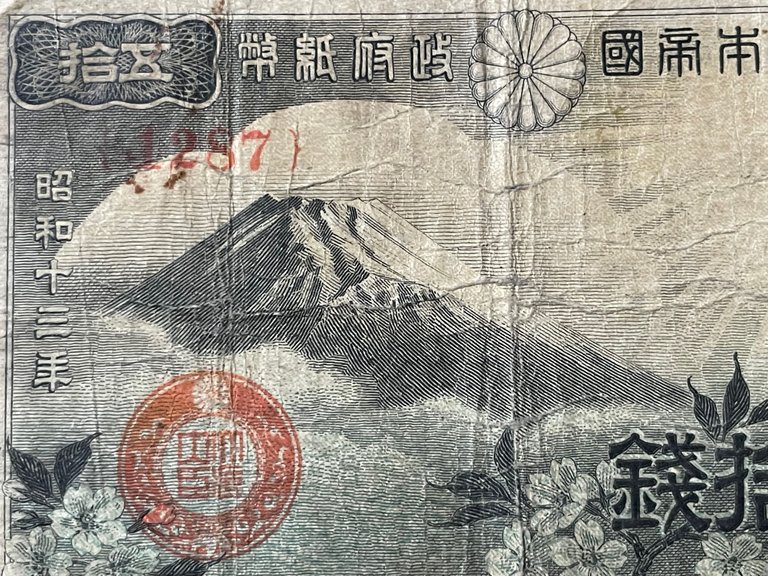
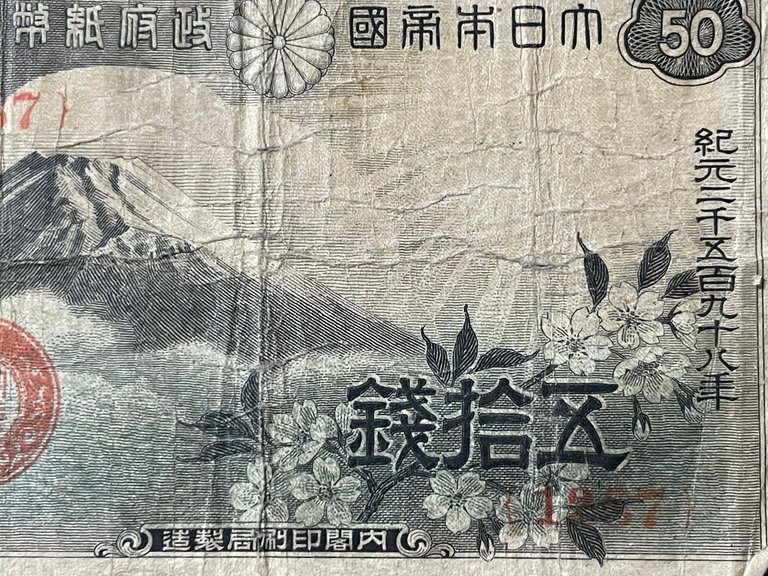
[Note: all horizontal text is reversed on the note. At the time Japanese was written right-to-left, but I am writing it left-to-right here.]
A nice design featuring Mount Fuji and some cherry blossoms. Top left we have 五拾 (gojū), "fifty", then we have 大日本帝國 (dai nippon teikoku), "Empire of Great Japan". This is follower by the chrysanthemum seal of the Imperial House, then 政府紙幣 (seifu shihei), "government note", the a 50 in arabic numbers.
Down the left side we have 昭和十三年 (shōwa jūsan nen), "Shōwa 13" which is the Japanese way of writing 1938.
I think I usually ignore the seals on the notes (the red circle stamp) because they are difficult for me to read, but I figured this one out. It is 大藏大臣 (daizou daijin), "Minister of Finance".
Down the right side is something we rarely see these days. It says 紀元二千五百九十八年 (kigen nisen gohyaku kyūjū nen), "Kigen 2598". This refers to the Imperial dating system that was in use at the time, called Kigen or Kōki. The Kōki system took the mythological origin of Japan in 660 BCE by the legendary Emperor Jimmu as year 1. So you can see 2598 - 660 gives us 1938. This dating system was abolished by GHQ (the occupying Americans) after the war. These days this system is rarely seen outside of legal contexts (some old laws still use it) and use of it can be considered a sign of nationalism so it is generally avoided.
There is some nice symmetry on the note with the Shōwa year given vertically on the left and the imperial year given vertically on the right: two different ways to write the same year.
In bigger text we have 五拾錢 (gojū sen), "fifty sen". Then in tiny text at the bottom we have 内閣印刷局製造 (naikaku insatsu kyoku seizō), "Manufactured by the Cabinet Printing Bureau".
Reverse
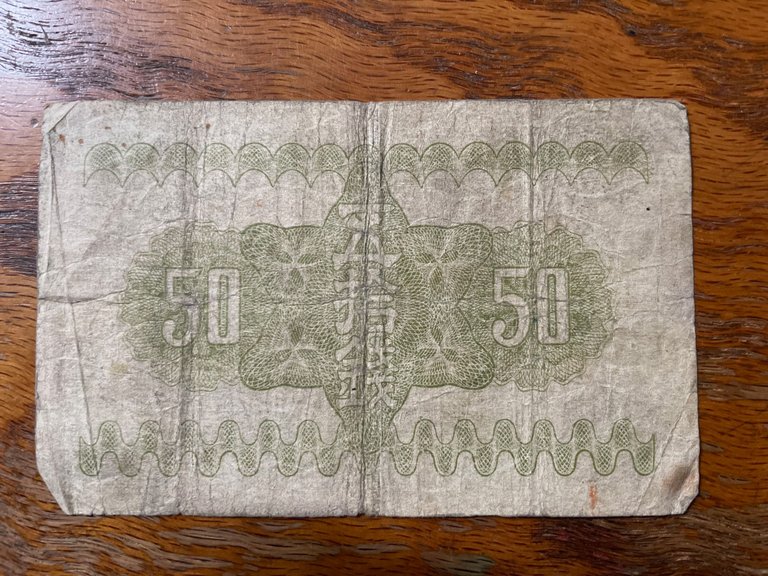
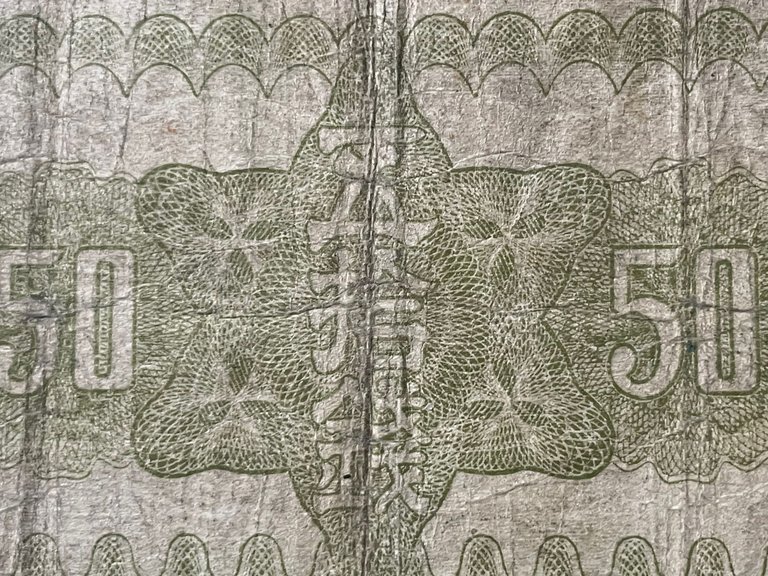
In contrast to the packed full front side, this side just gives us some nice design patterns, two 50's and in the middle 五拾錢 (gojū sen), "fifty sen".
Overall
This note was over produced, with them printing over a billion notes just in 1938. Therefore they are very easy to find these days and don't have much value even to collectors. You can easily (and cheaply) find much better copies that the one I am showing off here. But since it's so common and has a very low chance of becoming worth much to collectors, I didn't really feel like paying for a better copy.
The note lasted until 1948 when GHQ abolished it. The use of the imperial year and mention of the empire doomed it, as these things were verboten after the war. But by that point, hyperinflation was rapidly making the sen worthless anyway, and the denomination would be entirely removed in 1953.
So anyway, unlike some of the other notes I've shown in the past that do have some collectors value, this one is still worthless. But there is some historic value which is why I picked it up when I had the chance.
Let's end with a photo of the 50 sen note and the two 50 sen coins. Both versions of the coin were 80% silver. I know which one I'd prefer to have. Unfortunately unlike the note, the coins go for a lot from collectors and are tough to find for a reasonable price—especially that middle one. Oh well.
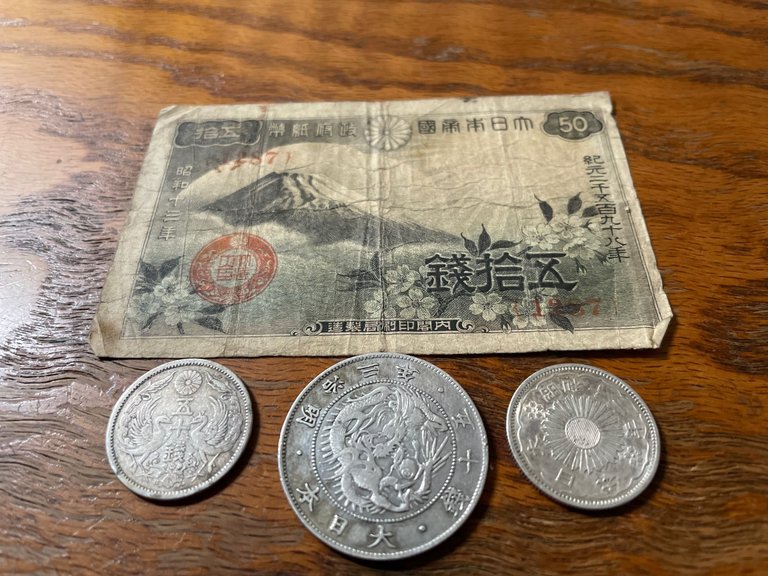
❦
 |
David LaSpina is an American photographer and translator lost in Japan, trying to capture the beauty of this country one photo at a time and searching for the perfect haiku. He blogs here and at laspina.org. Write him on Twitter or Mastodon. |
You received an upvote of 100% from Precious the Silver Mermaid!
Thank you for contributing more great content to the #SilverGoldStackers tag.
You have created a Precious Gem!
👏 Keep Up the good work on Hive ♦️ 👏
❤️ @bhattg suggested sagarkothari88 to upvote your post ❤️
🙏 Don't forget to Support Back 🙏
I honestly don't know if that is an indication of how useful the Sen still was or how horrible inflation is in the US!
Another example of how silver coin is far superior to banknotes in preserving your buying power.
!pimp !bbh
You must be killin' it out here!
@trumpman just slapped you with 5.000 PIMP, @dbooster.
You earned 5.000 PIMP for the strong hand.
They're getting a workout and slapped 2/3 possible people today.
Read about some PIMP Shit or Look for the PIMP District
Greetings @dbooster ,
A lovely well written and well presented post....appreciate seeing and hearing about that note.....and the additional bonus of those silver coins....thank you!
Kind Regards,
Bleujay
It still had some nice artwork put into it, that was a pretty design. Too bad they got overproduced. Governments are good at that sort of thing!
!LOL
lolztoken.com
Then it dawned on me.
Credit: benthomaswwd
@dbooster, I sent you an $LOLZ on behalf of thebighigg
(3/10)